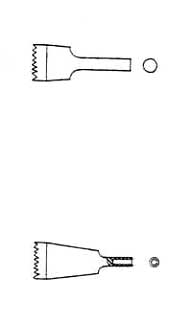The staking tool, punches, stumps
 THE STAKING TOOL
THE STAKING TOOL
The staking tool is a tool of many uses, such as, removing and replacing a balance staff, closing pivot holes, removing or replacing pinions, replacing hands, replacing a hairspring, etc. With a few exceptions the following information will apply to all staking tools.
The staking tool consists of the following parts: the staking frame, punches in various shapes and sizes, and stumps in various shapes and sizes.
STAKING FRAME
The punch guide A is aligned with the die plate В so that the punches will always be perpendicular to the die plate. The die plate may be turned so that any hole may be aligned with the punch. Turning the knurled wheel at С will lock the die plate in any desired position. The holes in the die plate are gauged and centered and give you the right spread of sizes from small to large.
STAKING PUNCHES
Practically all work on the staking tool will require that the proper hole in the die plate be aligned with the punch. The centering punch serves this purpose.
STAKING FRAME
CENTERING PUNCH
First determine the hole in the die plate to be used. Then insert the centering punch through the punch guide into the hole in the die plate and lock the die plate in position before removing the punch.
 ROUND FACED HOLLOW PUNCH
ROUND FACED HOLLOW PUNCH
Its most common use is in staking balance staffs. After the die plate has been centered, the staff with wheel in place is placed in the die plate, and a round faced hollow punch of a size just slightly larger than the collet seat is used to spread the rivet on the staff.

FLAT FACED HOLLOW PUNCH
Used for finishing the riveting of balance staffs. After using round faced hollow punch to spread the rivet, a flat faced hollow punch of the same size hole is used to finish off the top of the riv et. This punch has many other uses, such as pressing the hair-spring collet on the staff, hands on watches, and the like.
 ROUND FACED SOLID PUNCH
ROUND FACED SOLID PUNCH
Generally used for closing pivot holes etc. The proper size of punch to use is determined by the size of the oil cup and should fitwn in illustration A. The bottom of the plate should be properly supported with a stump or hole in a minute hand, closing the hole on a single roller, and so forth.
 FLAT FACED SOLID PUNCH
FLAT FACED SOLID PUNCH
Generally used as an inverted stump.
HOLLOW TAPER MOUTH PUNCH
Used for closing holes, such as hour hand, and for closing collets etc. Use care in selecting the proper size of punch.
STAR PUNCH
Sometimes known as the triangular point punch. It is used to close the hole in rollers by raising small burrs equidistant around the edge of the hole.
CROSS HOLE PUNCHES
Used in removing and replacing Waltham friction staffs. These punches are designed to fit over the pivot and rest on the cone rather than against a shoulder.
ROLLER DRIVING PUNCH
This punch was designed to replace single rollers. It is a flat fact hollow punch with a slot cut in the edge to accomodate the roller jewel. Modern methods of replacing a roller do not require the use of this punch.
SCREW KNOCKING PUNCH
This punch is designed to drive out a screw which has been broken off in the plate. This is practical only if you have an oversize screw available and also a tap of the proper size to cut new threads, as the old threads will be stripped. The more practical method of removing a broken screw is to use an acid solution which will dissolve the steel screw and leave the brass or nickel threads intact.
INCABLOC ROLLER PUNCH
This punch is designed for use in replacing an incabloc roller. The incabloc roller has a raised edge on the bottom. This punch fits within this edge and so minimizes the possibility of damage to the roller.
STUMPS
The manufacturers have done little to modernize their assortment of stumps. In most staking sets may be found stumps no longer in common use, as more modern tools and methods have been devised. Using the inverted style of tool, any of the punches can be turned over and used as stumps.
FLAT FACE SOLID STUMP
This type of stump has a variety of uses. Most staking sets have several of these stumps in different sizes. They may be used any time a flat solid surface is desired.
FLAT FACE HOLLOW STUMPS
Most staking sets are equipped with these stumps in a variety of sizes. They may be used to support a plate when drilling, broaching, etc.
FLAT FACE TAPERED HOLLOW STUMPS
Used to support the hub on a Waltham friction type balance when the staff is being removed.
FLAT FACE STRAIGHT HOLE STUMP
Used to support a Waltham friction staff while the wheel is being staked on.
ROLLER REMOVING STUMPS
These stumps were designed for use in removing roller tables. More modern tools and methods have been devised to remove rollers.
| « Friction jeweling tools | A Practical Staking Set for Beginners » |